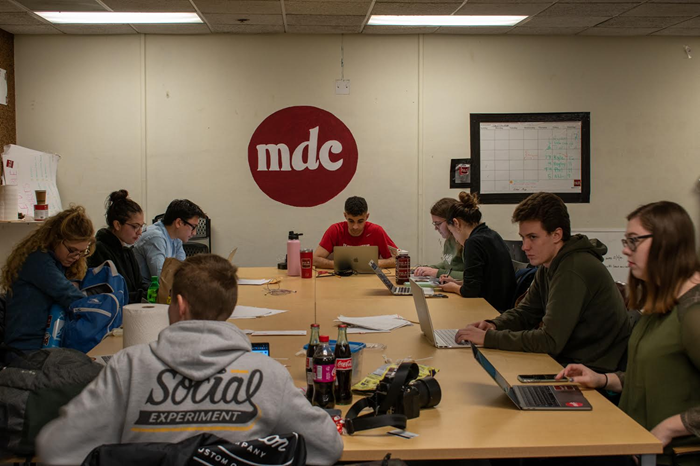Over the past decade, Everything Everything has mastered the art of being different.
Since 2007, the English art rock band has released four albums, steadily sprouting a dedicated fanbase that’s hungry for music which pushes the limit, challenging what’s acceptable in the mainstream. Whether it be an unorthodox time signature, an impressive vocal performance from lead singer Jonathan Higgs or a quirky homemade music video, the band has developed a unique ethos that has fascinated fans for years.
As one of few modern bands that has managed to thrive off of creating experimental rock and pop music, Everything Everything has amassed over 600,000 monthly listeners on Spotify — one way to gauge the popularity of an artist in today’s world of music streaming. “Distant Past”, the band’s most streamed track and a tune often heard at festivals and clubs, embraces their quirkiness as Higgs fuses bizarre (and graphic) lyrics with a fast-paced, high-pitched chorus that melts into your memory.
Each album in the band’s discography alternates between ideas of dark and light, happy and sad, pop and rock. “Get To Heaven”, the band’s third and most commercially successful album, explores ideas of being young and what it means to be alive. The colorful album cover of a person being hit in the face accurately foreshadows how the sonically bold songs, as listeners are overwhelmed with the pop-fueled punches that are “To The Blade”, “Spring/Sun/Winter/Dread” and “Blast Doors”.
The band’s most recent album, “A Fever Dream”, provides a stark contrast to the upbeat and pop-dominated record. Drawing influence from political turmoil around the world, namely Brexit and the 2016 U.S. presidential election, the band turned to darker themes of war with the bold opening track “Night of the Long Knives”, a pleading melody of dissatisfaction with the explosive “Desire”, and the haunting “Good Shot, Good Soldier”, an existential and dark exploration into being human.
Several tracks from the band’s fifth album “Re-Animator” hint at yet another drastic change of course for the artists. As they combine elements of pop rock and electronic music with Higgs’ usual vocal oddities, paired with a pandemic backdrop, tracks like “Arch Enemy”, “Violent Sun” and “In Birdsong” are promising signs for fans that the band will deliver another album filled with substance, complexity and character.
In August, drummer Michael Spearman, a Berklee College of Music alum, spoke with the Daily Collegian over the phone about the album’s release, creating music during a pandemic and how the band thrives despite the competitive music landscape. Read the full interview below.
“Re-Animator” will be released on Friday.
How has the band been functioning throughout the pandemic? How has your process changed?
In some ways, musicians are kind of used to this — being home and working. I think we’ve done OK. We’ve had a challenging year besides the pandemic. A fire in the warehouse burned all of our equipment, but the real downside is not being able to play shows.
We’re in constant contact, we’ve done more Zoom calls and group phone calls than normal. We’ve made videos without being in the same room at same time, and we’re just trying to get the artwork done without being in real life. We’re just sad at not being able to play shows to people in real life.
In recent months, the band has released music videos for each single on the new album. Two of them are animated, and one features the band members running through streets. How were these made?
“Violent Sun” was my idea. I was in the countryside for a lot of lockdown, staying with my parents for a couple of months. The whole point of [the song] is it has a feel about moving and running. So, I thought why don’t we do a sort of relay race?
It obviously isn’t real, but we could do some sort of trickery to make it look like we’re passing something from one to another, like a relay race. I’m in the countryside so I could pass it to Alex, who lives kind of in a country town, and then make it more urban as we go. The problem was having enough different interesting footage to use. We spent a lot of time repeating ourselves.
The purity of my idea kind of went out the window, but we kept the running aspect. I would look at my phone for the lyrics, then I’d do a bit of the lyrics and sing them the right way. We didn’t want it to look like we were going for a jog. It was all like sprints. Alex just ran and didn’t sing, so he had to redo it. I did it throughout the day and it took four hours. I think it came out well and it was worth the pain. [It was] the hottest day of the year, so that was not ideal.
The rest of the video was old school, recorded the other at our studio. We couldn’t have any crew, so we just shot it ourselves with GoPros. We were kind of our own cameramen, just the four of us in this white photo studio.
Jon has mentioned that his vocal range came from attempting to sing Radiohead songs. Do you have any influences of that sort with drumming?
I’m a bit of a funny drummer because I don’t tend to listen to music for the drums or anything like that. Radiohead, I think what they do with time signatures — they’re quite innovative with their use of rhythm. When I was growing up, I played the drums at first. I was into a lot of Queen. I was a big Ringo fan. I was playing a lot of jazz at school, so there’s jazz drums that I gravitated toward.
Many of the band’s songs play with strange time signatures. Do you come up with these, or is it a collaborative effort?
We talk about how we can do things; it really depends. Sometimes I say we should do a song in 7 or 9 or whatever, and then we divide those time signatures that have natural proportions and look at different ways of doing them. That’s what Radiohead did, playing 6, 7, or 5 or whatever. That’s quite fun.
On the new record, there’s “Lord of the Trapdoor”, which is in 5. That used to be in 6. There’s something about 6, we talk about it feeling a bit too comfortable. But the next thing I heard when Alex sent the demo, he just lopped off the last beat.
Alex is very much coming from a guitar [standpoint]. He’s not a drummer so sometimes he writes drum parts on software and makes things I definitely wouldn’t have thought of. It’s quite fun. Like “Warm Healer”, he wrote that on a laptop. I remember thinking, “That’s really quite strange,” trying to play that and make it feel okay. That’s in 6/4 I think.
It’s a fun band to be a drummer in because they’re always trying to do – actually on this album we’re probably feeling a bit more comfortable playing more obvious parts – but on the whole of it, we’re trying to find fresh ways other than just 2 and 4. But as I say quite a lot, sometimes clichés are clichés because they are the best ways.
Sometimes, well, I can’t play [a song] because I don’t have enough arms. It’s an interesting process of a little bit of back and forth. But the odd part, because of the way they write, is they start with the drums first. I do get some programmed beats, but as a whole they’ll base a song on drums anyway and then it’ll be reverse engineering.

Are there any songs you’re particularly fond of playing? What about on the new album?
I enjoy them for different reasons. On “Get To Heaven”, it’s not the most innovative drum part but it serves the song well. I like how simple it is. Especially the most “interesting” songs — the hardest ones to play — I like playing them, but sometimes I’m like, “Shit this is tricky.” Whereas something like “Spring/Sun/Winter/Dread”, I can play this and not really think too hard.
I got good at playing “Warm Healer”. When I was playing that well, it was cool. It’s really fiddly and it was just fun playing that song in quite big venues. I’ve been really enjoying playing one called “Black Hyena”, which is a loop through but it’s kind of odd, I like playing it. It’s a bit strange. I think the fans are going to like that one.
Does the group have a vision for future music?
We have loads of just kind of quiet songs, but we said, “Do we want to make a record like this?” We decided to make this full-throttle vibrant pop record. The other thing is it’s four people in the band, and we have different ideas of what we want this record to be. If a song doesn’t make it to the end, the actual end product is the tip of the iceberg.
There’s stuff that doesn’t get used, or demos along the way. We released the EP after the last record [of songs] that didn’t fit. Like “Breadwinner”, you can tell it wouldn’t fit onto “A Fever Dream”. It’s a different vibe.
What advice do you have for college students trying to break into the music industry or start a band of their own?
If I’m being honest, it’s important to be authentic to yourself and honest and just make stuff that you really believe in. If you are lucky enough to be given a chance to make something of your own, you might as well try to make it as authentic to you as possible and not guess what other people might want because I think that’s a problem a lot of people have. They want to be successful, but they want the successful bit first. But I think people are clever and smart and know if you’re being authentic. They can smell it.
So, rather than thinking, “How do I do be successful?” it’s more of, “How do I do the thing I want to do as well as possible?” Then you hope that other people will resonate with that and react to it. Our band, we could be more commercial, we could make things a bit simpler and have a more radio kind of sound, but it’s just not really quite what we want our music to be. We’ve stuck to our guns, and that’s not always the easy thing to do, but it feels like we’ve done what we want to do. As a band you have to justify your work to each other, be honest to yourself, work hard and hope the other stuff follows.
We also have a loyal fanbase. We feel very lucky to have our fanbase and that they’re open-minded. When we change things up a bit they come with us, they stick with us and they’re patient with us. It’s very hard to get that and we feel very grateful.
Matt Berg is the Managing Editor and can be reached at [email protected]. Follow him on Twitter @mattberg33.




















